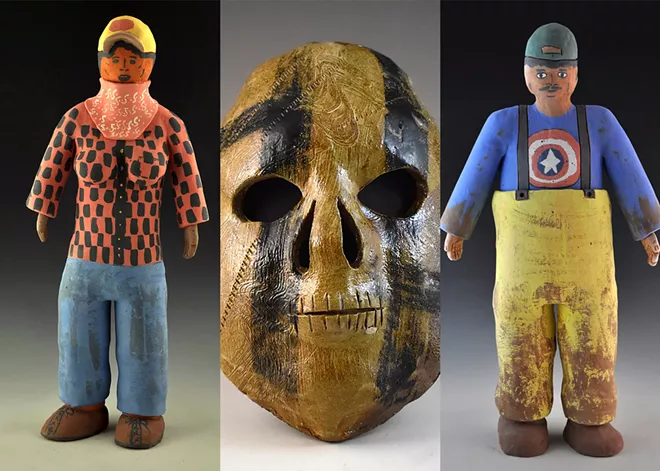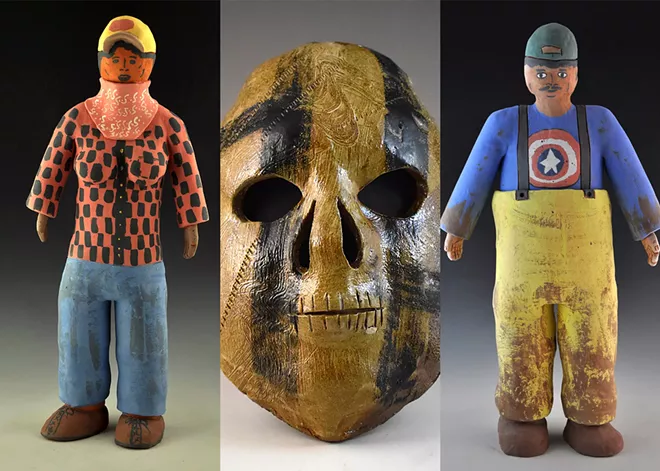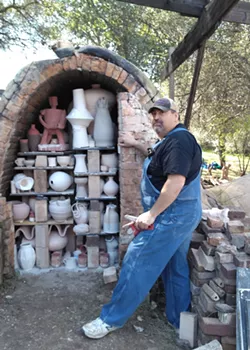Clay is not dirt, although the two are related. Clay is some of our planet’s rock supply continuously decomposing. It’s found worldwide near earth’s varied waterways but also on its surface, where it’s a key ingredient in soil, aka dirt. And while humans have been farming earth’s dirt an impressive 12,000 years, they’ve been harvesting the earth itself in the form of clay for more than twice that long.
For artist Angel Olegario Luna, the relationship of dirt to clay is a powerful one, a personal one that connects family, food and culture.
“One of the reasons I’ve held onto ceramics — clay — as my main medium is because of growing up in the fields,” explains Luna, whose exhibition of ceramic figures, masks and other work opens at Marmot Art Space on Friday, July 4.
“I’ve worked in the earth from when I was a child following my dad as he would change sprinklers or shovel,” Luna continues.
He grew up in Prosser, Washington, where his mother recently retired from a cherry packing plant. From age 14, Luna spent six summers working alongside family members and a community of pickers and packers, predominantly of Mexican heritage, and whose labor keeps Prosser on the agricultural map.
“You’re getting paid to do it, and you’re working the fields of somebody who owns that land, but you know at the end that what you’re creating is going out there to feed people,” Luna says.
It was — still is — honest work, says Luna. And the experience shaped much of his life, from his intense work ethic to the artwork he’s been making for more than 25 years.
“I didn’t know I could create with the hands that had been working my whole life.”
For example, his series of rustic clay figures, “Gente (People) Not Numbers,” dates to around 2004, shortly after Luna graduated from University of Idaho with his master’s in fine art. All are based on a real person or situation, ranging from the farmworkers of his youth to Luna’s urban experiences, including the greater Phoenix, Arizona, area where he currently teaches ceramics at Mesa Community College.
“The series over the years has changed and grown, but I still create them,” Luna writes in his artist statement. “The message has not changed. People are not replaceable, and the experiences you have daily with people you work with are valid. The stories need to be told and documented.”
The story of Luna’s artistic journey moves in loops.
During his sophomore year in high school, Luna took an Advanced Placement U.S. history class, and although he admits he didn’t score well on the final, he was inspired to learn more.
“The teacher that taught it got me learning more about the history of Latino and Hispanic workers,” says Luna, who initially pursued a double major in history and secondary education at Whitworth University.
To fulfill a humanities credit, he enrolled in a ceramics class taught by former Whitworth instructor Jeff Harris (you can find Harris’ work at Pottery Place Plus in downtown Spokane). Luna discovered the magic of clay, which is rather like earth’s first plastic: incredibly flexible in liquid form yet rock-like when transformed by extreme heat.
“I didn’t know I could create with the hands that had been working my whole life” in more practical ways, Luna says.
After graduating from Whitworth with a Bachelor of Arts in history, Luna pursued his Bachelor of Fine Arts at Eastern Washington University. There he was mentored by the late Rubén Trejo, whose Michoacan heritage, advancement of Chicano and Latino art and issues, and similar experiences in agricultural labor resonated with Luna.
Under Trejo, Luna experimented with a range of media including bronze sculpture, for which Trejo was well-known. Luna’s calavera, or skull masks, which are based on his own face, are an evolution of Trejo’s mold making instruction, allowing Luna to make countless multiples. He sells the masks through his website (angellunaartworks.com) and via Etsy, but also uses them as test surfaces for his extensive catalog of firing, glazing and clay decoration techniques.
After EWU, Luna pursued his master’s at U of I. There he found another mentor in Glenn Grishkoff, known for his expert and innovative brush making, as well as his ceramics and performance art.
Before Trejo died in 2009, Luna introduced Grishkoff to Trejo, whose work is also represented at Marmot Art Space gallery. That, in turn, led to Grishkoff discussing his former graduate students’ work with Marmot gallery founder, Marshall Peterson, who took an interest in Luna’s work.
As Luna winds down classes at Mesa Community College and preps for his Spokane exhibit, he is reflective about his journey thus far.
“I am a product of my teachers,” Luna says. “Every time that there was a roadblock, I had a teacher that knocked the door down for me or knocked the wall out of the way.”
It’s something he takes to heart in his own teaching, including a one-of-a-kind workshop focusing on surfaces and glazes as rigorous as any class at a four-year university.
“I’m giving [students] an encyclopedia of surfaces for them to be able to use any of those tools in their toolbox to create their work, and that’s how I approach my work now,” Luna says. “That’s something I would say Rubén taught me … not to be limited by [anything, so] if I have an idea, do the material or process that needs to be done for that idea.”
Another Trejo takeaway: “Just to make the work honest,” Luna says, noting that this advice paralleled how he was raised, including working in the fields.
“If you make things that are honest, people will appreciate it or understand it or try to understand it or try to learn more about it.” ♦
Angel Olegario Luna • July 4-26; open Fri-Sat from 3-6 pm or by appointment • Artist reception: July 4 from 5-8 pm • Free • Marmot Art Space • 1202 W. Summit Pkwy. • marmotartspace.com • 509-270-5804








